Publications by Kelly J Cunningham
This article explores the application of science identity development theory for women of color i... more This article explores the application of science identity development theory for women of color interested in the science disciplines; and it advocates for taking an intersectional approach to understanding how women of color form science identities. The article also challenges community college administrators and scholars to focus on redefining science identity development theory within the community college setting as a means to enhance success for women of color pursuing academic work in scientific disciplines.
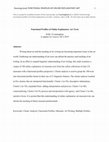
Writing about art and the teaching of art writing are becoming important issues in the art world.... more Writing about art and the teaching of art writing are becoming important issues in the art world. Furthering our understanding of art texts can inform the practice and teaching of art writing. In an effort to expand linguistic understanding of art writing, this study examines a corpus of 180 online explanatory art museum texts from the online collections of nine US museums with a functional profiles perspective. Cluster analysis is used to group the 180 texts into functional profiles based on their use of 21 linguistic features. The cluster analysis resulted in five clusters that are interpreted functionally: Cluster 1 (n=56), descriptive information; Cluster 2 (n=30), expanded form-adding interpretation and process; Cluster 3 (n=40), contextualizing; Cluster 4 (n=8), process and interpretation with agency; and Cluster 5 (n-46), narrative focus. It is posited that this understanding of online explanatory art museum texts can inform the teaching of future museum professionals.
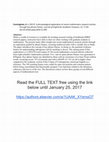
While a wealth of resources is available for teaching research writing of traditional IMRD resear... more While a wealth of resources is available for teaching research writing of traditional IMRD research papers, instructors have little to draw on when working with graduate students in mathematics. The present study offers insight into recent mathematical research articles through an exploration guided by phrase-frames, recurring multiword units with a variable slot or blank. The paper introduces the concept of key phrase-frames. In doing so, the potential of phrase-frames for understanding subregisters and for teaching is shown. The starting point of this exploration is a 2,289,670-word corpus of 128 recent mathematics research articles collected from eight scholarly mathematics journals. Five-and six-gram phrase-frames were generated in KfNgram. Key phrase frames are identified as those with an occurrence of at least 20 per million words, occurring across 75% of journals and with a sMAPE of 1.95 cut off or higher when compared to the academic section of the Corpus of Contemporary American English as a reference. The 180 resulting frames were coded for open slot position and common pattern before being consolidated and functionally grouped. Core functions related to the aboutness, coherence and moves of the text. The discussion centers on how these groups reveal different aspects of mathematical texts
The Google Art Project can be used to unlock student interest and motivate them to use language c... more The Google Art Project can be used to unlock student interest and motivate them to use language creatively as they explore the world’s museums. It offers an international platform that connects users with art and objects around the world and throughout time, allowing visitors to explore and connect with culture and language in new and intriguing ways.
Cunningham, K. J. (2013). Exploring language through the worlds' museums. Paper presented at the MIDTESOL 2013: "Engaging Learners, Building Community", Lawrence, KS.
in Morrison, J. (ed.) (2015). The conference proceedings of MIDTESOL: Cultivating best practices in
ESL. http://midtesol.org/wp-content/uploads/2015/11/MIDTESOL-Proceedings_Final-document_2013-14.pdf
Presentations by Kelly J Cunningham
This presentation discusses the potential of a physiological measure, electrodermal activity (EDA... more This presentation discusses the potential of a physiological measure, electrodermal activity (EDA), as a measure of mental effort in SLW research. Results across two types of ESL writing feedback and EDA alongside gaze replays of revision will be used in addition to interview and survey results to showcase this potential.

Public texts, such as museum wall texts, can reveal the attitude and intended audience of an orga... more Public texts, such as museum wall texts, can reveal the attitude and intended audience of an organization. Museum visitors use the language within the text to help them decide whether an exhibit is good or bad, approa or esoteric. Understanding what these texts are doing and how they are perceived by others can aid in crafting te that match the intended purpose of the organization. For a museum, this is critical. To fail to understand this can not only to poor reviews but also to the alienation of visitors. To deepen our understanding of such texts, this study examined the wall texts (n=55) of two shows with contrasti reviews at the 2014 Whitney Biennial. First, a move framework for the art museum wall texts was developed. Af coding the texts using this framework, the individual moves and steps within each show were further examined fo evidence of popularization features. The analysis showed differences in move presence, length and focus as well popularization features between the two shows. These differences can help shed light on contrasting reviews and the curatorial purposes of the two shows. The move framework established here may assist in future studies of art museum texts and be useful to those who teach or work in museum and curatorial studies.
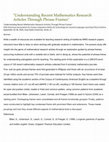
While a wealth of resources are available for teaching research writing of traditional IMRD resea... more While a wealth of resources are available for teaching research writing of traditional IMRD research papers, instructors have little to draw on when working with graduate students in mathematics. The present study offers insight into the genre of mathematical research articles through an exploration guided by phrase-frames, reoccurring multiword units with a variable slot or blank, and in doing so, shows the potential of phrase-frames for understanding subregisters and for teaching. The starting point of this exploration is a 2,289,670-word corpus of 128 recent mathematics research articles collected from 8 scholarly mathematics journals. Five- and six-gram phrase-frames were first generated in KfNgram and those with an occurrence of at least 20 per million words and across 75% of journals were retained for further analysis. Key frames were then identified using the academic section of the Corpus of Contemporary American English as a baseline through inverse relative error (.01 cut off) and sMAPE (1.95 cut off), resulting in 180 frames. Each frame was coded for open slot position (initial, medial or final) and common pattern, using common patterns from academic lexical bundles from Biber, Johansson, Leech, Conrad, and Finegan (1999) as used in Hyland (2008) as a starting point. Overlapping frames were consolidated and all frames functionally grouped. Finally, patterns were constructed to highlight key condensed frame with prominent fillers and extensions. These master groupings and how they reveal different aspects of mathematical texts is discussed.
Appraisal analysis reveals differences in instructor position & feedback role through the use of ... more Appraisal analysis reveals differences in instructor position & feedback role through the use of evaluative language in text and screencast feedback in ESL writing.
full presentation at eslcunningham.com
This presentation explores how the use of evaluative language differs between parallel corpora o... more This presentation explores how the use of evaluative language differs between parallel corpora of text and screencast feedback and what this means for the role of feedback and position of instructor. In understanding the implications of technology choices, instructors can better match tools to their pedagogical purposes.
full presentation available at eslcunningham.com http://sites.google.com/site/itbecunningham/home/how-‐technology-‐shapes-‐our-‐language-‐ feedback-‐mode-‐matters
full presentation available at eslcunningham.com http://sites.google.com/site/itbecunningham/home... more full presentation available at eslcunningham.com http://sites.google.com/site/itbecunningham/home/-‐the-‐language-‐of-‐evaluation-‐in-‐written-‐ screencast-‐instructor-‐feedback-‐on-‐esl-‐writing-‐an-‐appraisal-‐analysis-‐aaal-‐2017
abstract: This presentation explores the appraisal resources used by 3 instructors in their text and screencast video feedback on ESL writing. This study of the language of evaluation sheds light on how the position of the instructor and role of feedback may shift with technology use.
Screencast video feedback is often seen as positive, easier to understand and more personal by st... more Screencast video feedback is often seen as positive, easier to understand and more personal by students while leading to the same or higher rates of successful application. Augmented by glimpses of student perspectives, this presentation will turn the focus on the instructors giving the feedback. The presentation discusses results of a semester long counterbalanced study of the perspectives of 4 ESL writing instructors implementing screencast feedback in their classes for the first time as they compare using it to using MS Word comments. How does the use of text and screencast feedback impact the instructor giving the feedback?
Presentation can be viewed with animation at https://sites.google.com/site/itbecunningham/home/te... more Presentation can be viewed with animation at https://sites.google.com/site/itbecunningham/home/teacher-‐student-‐perspectives-‐on-‐ screencast-‐text-‐feedback-‐in-‐esl-‐writing-‐calico-‐2016
Abstract:
In making choices about technology-mediated feedback, an understanding of the considerations from both the student and instructor perspectives is important. This presentation reports on the findings of a study of student and instructor perspectives on screencast and MS Word comment feedback on student ESL writing. The multiple measures within-groups study looks at how these perspectives change with continued exposure and how student and instructor perspectives compare.
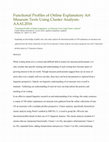
Summary: Expanding our knowledge of public texts, this study explores the functional profiles of ... more Summary: Expanding our knowledge of public texts, this study explores the functional profiles of 180 explanatory art museum texts gathered from the online collections of nine US art museums. Cluster analysis was used to group the texts into 5 functional profiles based on 21 linguistics features.
Abstract:
While writing about art is a critical and difficult skill to master for museum professionals, it is only recently that specific training and understanding of such writing have become topics of growing interest in the art world. Though museum professionals suggest there are an array of styles that even a simple wall text can take, these have not been documented or explored from a linguistic perspective. Indeed, our linguistic understanding of art museum texts overall is minimal. Furthering our understanding of such art texts can help inform the practice and teaching of art writing. In an effort to expand linguistic research on and understanding of art writing, this study examines a corpus of 180 online explanatory art museum texts gathered from the online collections of nine US art museums with a multiple profiles perspective. Cluster analysis, specifically hierarchical cluster analysis using Ward's method in JMP Pro 11, is used to group the 180 texts into functional profiles based on their use of 21 linguistic features. The cluster analysis resulted in 5 clusters that are interpreted functionally: Cluster 1 (n=56), descriptive informational; Cluster 2 (n=30), expanded form-adding interpretation and process; Cluster 3 (n=40), contextualizing;
Graduate peer review groups were one of the first steps in renewing graduate student communicatio... more Graduate peer review groups were one of the first steps in renewing graduate student communication support and resources on campus. These disciplinary groups meet weekly for presentation & review of work. Come learn how the groups evolved & how they’ve helped students re-envision their work without exchanging papers.
"Want to Change Your Feedback? Try Video"
MELEd 2015- Minnesota English Learner Education Confer... more "Want to Change Your Feedback? Try Video"
MELEd 2015- Minnesota English Learner Education Conference
2 pm Saturday, November 7, 2015
Edina 225, DoubleTree by Hilton, Bloomington, MN
Abstract
This presentation will share the results of a mixed methods study looking at the differences between MS Word comments & screencast video feedback in an intermediate ESL writing course in an intensive English program. Learn how efficiency, effectiveness, perceptions and the language of feedback change when using video feedback.
MIDTESOL 2015- The Future is Now: Building New Traditions in TESOL
9:45 am Saturday October 24, ... more MIDTESOL 2015- The Future is Now: Building New Traditions in TESOL
9:45 am Saturday October 24, 2015
Michigan Room, Iowa Memorial Union, University of Iowa, Iowa City, IA
Graduate peer review groups bring together students from complementary disciplines to give and apply feedback on scholarly work. These groups function as supportive communities that have proven particularly beneficial for ESL graduate students. Learn how graduate ESL students benefit from peer review groups and how to create them at your institution.
Situated in Systemic Functional Linguistics, this study used the appraisal framework to analyze i... more Situated in Systemic Functional Linguistics, this study used the appraisal framework to analyze instructor feedback given by way of MS Word comments and screencast video, with a focus on interpersonal language use. Using a crossover design to collect 2 instances of feedback per student, the feedback collected was analyzed with a focus on appreciation to show the targets of and positive/negative evaluation and engagement to reveal the power distance and potential for dialogue. In addition, these aspects of appraisal were also coded for graduation to show the degree of intensity or hedging present. Such analysis revealed difference in the position taken by the instructor when giving feedback through different modes, and difference in the way feedback is presented from a dichotomy of correct/incorrect to a continuum of correctness and language choice.
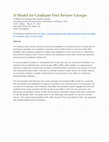
The ability to give, receive and use constructive feedback on scholarly work is a critical part o... more The ability to give, receive and use constructive feedback on scholarly work is a critical part of becoming a member of an academic institution and a professional in a research field. With qualifiers often requiring students to obtain peer feedback on their work prior to submission, and journals relying on peer review to determine publication worth, peer review has become a central tenant of graduate student life. To assist graduate students in developing skills to provide and use constructive feedback, our university has established peer review groups (PRGs). PRGs offer students an opportunity to cultivate a supportive professional scholarly community while investing in the process of critical and constructive peer review. Contrary to common notions of peer review, our model requires no exchange of papers, instead condensing the review process to an efficient community oriented weekly meeting. This presentation will showcase the recent evolution of a graduate PRG model at a university. The presentation will elaborate on aspects of student access and placement in the groups, the structure of the groups, and scalability. How PRGs can promote student engagement with and visibility of the larger program will also be discussed. With a short time for questions and discussion and perhaps a demo of the review process, attendees should leave with a solid idea of how the groups work, including some of the challenges and benefits of various structure choices. This will provide attendees with a PRG blueprint they may adapt for their own graduate and undergraduate home institutions.

12th Annual Technology for Second Language Learning( TSLL 2014 )- Beyond Form: Functional Perspec... more 12th Annual Technology for Second Language Learning( TSLL 2014 )- Beyond Form: Functional Perspectives on CALL Research & Teaching
Iowa State University, Ames, IA
Friday Sept. 12, 2014
by Kelly J Cunningham
This study uses a systemic functional linguistics (SFL) framework to look at how the mode of technology influences the way feedback is given in an intermediate ESL writing course for the purpose of revision. Following a study of twelve participants who revised based on feedback given by electronic text or screencast in a counterbalanced/cross over design over four assignments, the screencast feedback itself was studied initially with a qualitative key word analysis. This analysis brought up elements of the interpersonal metafunction, which prompted further analysis using this lens to better understand the differences between the two technology-mediated modes of feedback.
This presentation explores the use of the interpersonal in technology-mediated feedback on intermediate ESL writing and its potential impact on the use of feedback for revision by tying this discussion of the interpersonal metafunction with a focus on modality & appraisal to the observed student use of feedback, rate of successful revisions tied to feedback and survey responses and interviews relating to student perceptions of the feedback. These findings suggest that simply by changing the technology used to provide feedback, and by doing so changing the mode in which it is provided, in second language writing, we may better address the interpersonal and in doing so, feedback shifts in such a way that become more approachable, understandable and thereby effective for revision.


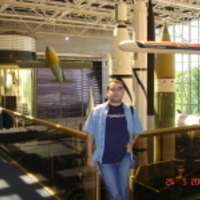








Uploads
Publications by Kelly J Cunningham
Cunningham, K. J. (2013). Exploring language through the worlds' museums. Paper presented at the MIDTESOL 2013: "Engaging Learners, Building Community", Lawrence, KS.
in Morrison, J. (ed.) (2015). The conference proceedings of MIDTESOL: Cultivating best practices in
ESL. http://midtesol.org/wp-content/uploads/2015/11/MIDTESOL-Proceedings_Final-document_2013-14.pdf
Presentations by Kelly J Cunningham
"Are Our Technology Choices Changing the Nature of Our Feedback? An Appraisal Analysis of MS Word & Screencast Instructor Commentary on ESL Writing"
Symposium on Second Language Writing 2016: Expertise in Second Language Writing
October 20-22, Arizona State University, Tempe, Arizona, USA
https://sites.google.com/site/itbecunningham/home/-are-our-technology-choices-changing-the-nature-of-our-feedback-an-appraisal-analysis-of-ms-word-screencast-instructor-commentary-on-esl-writing
full presentation at eslcunningham.com
full presentation available at eslcunningham.com http://sites.google.com/site/itbecunningham/home/how-‐technology-‐shapes-‐our-‐language-‐ feedback-‐mode-‐matters
abstract: This presentation explores the appraisal resources used by 3 instructors in their text and screencast video feedback on ESL writing. This study of the language of evaluation sheds light on how the position of the instructor and role of feedback may shift with technology use.
Abstract:
In making choices about technology-mediated feedback, an understanding of the considerations from both the student and instructor perspectives is important. This presentation reports on the findings of a study of student and instructor perspectives on screencast and MS Word comment feedback on student ESL writing. The multiple measures within-groups study looks at how these perspectives change with continued exposure and how student and instructor perspectives compare.
Abstract:
While writing about art is a critical and difficult skill to master for museum professionals, it is only recently that specific training and understanding of such writing have become topics of growing interest in the art world. Though museum professionals suggest there are an array of styles that even a simple wall text can take, these have not been documented or explored from a linguistic perspective. Indeed, our linguistic understanding of art museum texts overall is minimal. Furthering our understanding of such art texts can help inform the practice and teaching of art writing. In an effort to expand linguistic research on and understanding of art writing, this study examines a corpus of 180 online explanatory art museum texts gathered from the online collections of nine US art museums with a multiple profiles perspective. Cluster analysis, specifically hierarchical cluster analysis using Ward's method in JMP Pro 11, is used to group the 180 texts into functional profiles based on their use of 21 linguistic features. The cluster analysis resulted in 5 clusters that are interpreted functionally: Cluster 1 (n=56), descriptive informational; Cluster 2 (n=30), expanded form-adding interpretation and process; Cluster 3 (n=40), contextualizing;
MELEd 2015- Minnesota English Learner Education Conference
2 pm Saturday, November 7, 2015
Edina 225, DoubleTree by Hilton, Bloomington, MN
Abstract
This presentation will share the results of a mixed methods study looking at the differences between MS Word comments & screencast video feedback in an intermediate ESL writing course in an intensive English program. Learn how efficiency, effectiveness, perceptions and the language of feedback change when using video feedback.
9:45 am Saturday October 24, 2015
Michigan Room, Iowa Memorial Union, University of Iowa, Iowa City, IA
Graduate peer review groups bring together students from complementary disciplines to give and apply feedback on scholarly work. These groups function as supportive communities that have proven particularly beneficial for ESL graduate students. Learn how graduate ESL students benefit from peer review groups and how to create them at your institution.
Iowa State University, Ames, IA
Friday Sept. 12, 2014
by Kelly J Cunningham
This study uses a systemic functional linguistics (SFL) framework to look at how the mode of technology influences the way feedback is given in an intermediate ESL writing course for the purpose of revision. Following a study of twelve participants who revised based on feedback given by electronic text or screencast in a counterbalanced/cross over design over four assignments, the screencast feedback itself was studied initially with a qualitative key word analysis. This analysis brought up elements of the interpersonal metafunction, which prompted further analysis using this lens to better understand the differences between the two technology-mediated modes of feedback.
This presentation explores the use of the interpersonal in technology-mediated feedback on intermediate ESL writing and its potential impact on the use of feedback for revision by tying this discussion of the interpersonal metafunction with a focus on modality & appraisal to the observed student use of feedback, rate of successful revisions tied to feedback and survey responses and interviews relating to student perceptions of the feedback. These findings suggest that simply by changing the technology used to provide feedback, and by doing so changing the mode in which it is provided, in second language writing, we may better address the interpersonal and in doing so, feedback shifts in such a way that become more approachable, understandable and thereby effective for revision.
Cunningham, K. J. (2013). Exploring language through the worlds' museums. Paper presented at the MIDTESOL 2013: "Engaging Learners, Building Community", Lawrence, KS.
in Morrison, J. (ed.) (2015). The conference proceedings of MIDTESOL: Cultivating best practices in
ESL. http://midtesol.org/wp-content/uploads/2015/11/MIDTESOL-Proceedings_Final-document_2013-14.pdf
"Are Our Technology Choices Changing the Nature of Our Feedback? An Appraisal Analysis of MS Word & Screencast Instructor Commentary on ESL Writing"
Symposium on Second Language Writing 2016: Expertise in Second Language Writing
October 20-22, Arizona State University, Tempe, Arizona, USA
https://sites.google.com/site/itbecunningham/home/-are-our-technology-choices-changing-the-nature-of-our-feedback-an-appraisal-analysis-of-ms-word-screencast-instructor-commentary-on-esl-writing
full presentation at eslcunningham.com
full presentation available at eslcunningham.com http://sites.google.com/site/itbecunningham/home/how-‐technology-‐shapes-‐our-‐language-‐ feedback-‐mode-‐matters
abstract: This presentation explores the appraisal resources used by 3 instructors in their text and screencast video feedback on ESL writing. This study of the language of evaluation sheds light on how the position of the instructor and role of feedback may shift with technology use.
Abstract:
In making choices about technology-mediated feedback, an understanding of the considerations from both the student and instructor perspectives is important. This presentation reports on the findings of a study of student and instructor perspectives on screencast and MS Word comment feedback on student ESL writing. The multiple measures within-groups study looks at how these perspectives change with continued exposure and how student and instructor perspectives compare.
Abstract:
While writing about art is a critical and difficult skill to master for museum professionals, it is only recently that specific training and understanding of such writing have become topics of growing interest in the art world. Though museum professionals suggest there are an array of styles that even a simple wall text can take, these have not been documented or explored from a linguistic perspective. Indeed, our linguistic understanding of art museum texts overall is minimal. Furthering our understanding of such art texts can help inform the practice and teaching of art writing. In an effort to expand linguistic research on and understanding of art writing, this study examines a corpus of 180 online explanatory art museum texts gathered from the online collections of nine US art museums with a multiple profiles perspective. Cluster analysis, specifically hierarchical cluster analysis using Ward's method in JMP Pro 11, is used to group the 180 texts into functional profiles based on their use of 21 linguistic features. The cluster analysis resulted in 5 clusters that are interpreted functionally: Cluster 1 (n=56), descriptive informational; Cluster 2 (n=30), expanded form-adding interpretation and process; Cluster 3 (n=40), contextualizing;
MELEd 2015- Minnesota English Learner Education Conference
2 pm Saturday, November 7, 2015
Edina 225, DoubleTree by Hilton, Bloomington, MN
Abstract
This presentation will share the results of a mixed methods study looking at the differences between MS Word comments & screencast video feedback in an intermediate ESL writing course in an intensive English program. Learn how efficiency, effectiveness, perceptions and the language of feedback change when using video feedback.
9:45 am Saturday October 24, 2015
Michigan Room, Iowa Memorial Union, University of Iowa, Iowa City, IA
Graduate peer review groups bring together students from complementary disciplines to give and apply feedback on scholarly work. These groups function as supportive communities that have proven particularly beneficial for ESL graduate students. Learn how graduate ESL students benefit from peer review groups and how to create them at your institution.
Iowa State University, Ames, IA
Friday Sept. 12, 2014
by Kelly J Cunningham
This study uses a systemic functional linguistics (SFL) framework to look at how the mode of technology influences the way feedback is given in an intermediate ESL writing course for the purpose of revision. Following a study of twelve participants who revised based on feedback given by electronic text or screencast in a counterbalanced/cross over design over four assignments, the screencast feedback itself was studied initially with a qualitative key word analysis. This analysis brought up elements of the interpersonal metafunction, which prompted further analysis using this lens to better understand the differences between the two technology-mediated modes of feedback.
This presentation explores the use of the interpersonal in technology-mediated feedback on intermediate ESL writing and its potential impact on the use of feedback for revision by tying this discussion of the interpersonal metafunction with a focus on modality & appraisal to the observed student use of feedback, rate of successful revisions tied to feedback and survey responses and interviews relating to student perceptions of the feedback. These findings suggest that simply by changing the technology used to provide feedback, and by doing so changing the mode in which it is provided, in second language writing, we may better address the interpersonal and in doing so, feedback shifts in such a way that become more approachable, understandable and thereby effective for revision.
Lawrence, Kansas
by Kelly J Cunningham
Presentation Slides & Handout:
https://sites.google.com/site/itbecunningham/home/exploring-language-through-the-world-s-museums-w-the-google-art-project
Site Version of Activities:
https://sites.google.com/site/eslartproject/home/activities-by-content
An interactive website including tutorials and links to tools is available here- https://sites.google.com/site/itbecunningham/home/tech-tools-for-esl-teachers-at-all-levels
In addition, supplementary slide are available to view on the main page and a pdf handout of a selection of information can be found at the bottom of that page.
(PPT & Handouts available at link + multiple page of information and links to items discussed. https://sites.google.com/site/itbecunningham/home/tech-tools-for-esl-teachers-at-all-levels )